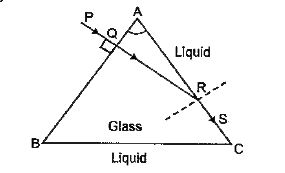A narrow beam of monochromatic light, PQ, is incident normally on one face of an equiangular glass prism of refractive index 1.45. When the prism is immersed in a certain liquid, the ray makes a grazing emergence along the other face (figure). Find the refractive index of this liquid .
To solve the problem of finding the refractive index of the liquid in which the equiangular glass prism is immersed, we can follow these steps:
Step 1: Understand the Geometry of the Prism
The prism is equiangular, which means all angles are equal. For an equiangular prism, the angle A is 60∘.
Step 2: Identify the Given Values
- Refractive index of glass, μg=1.45
- Angle of the prism, A=60∘
Step 3: Determine the Emergence Condition
When the light ray emerges from the prism grazing along the other face, it means that the angle of refraction at the second face is 90∘. This implies that the angle of incidence at the second face is equal to the critical angle for the glass-liquid interface.
Step 4: Use Snell's Law
According to Snell's Law:
μgsin(i)=μlsin(r)
Where:
- i is the angle of incidence at the second face (which is 60∘ for an equiangular prism).
- r is the angle of refraction (which is 90∘ since the ray grazes the surface).
Since sin(90∘)=1, we can simplify the equation:
μgsin(60∘)=μl⋅1
Step 5: Calculate sin(60∘)
We know:
sin(60∘)=√32
Step 6: Substitute Values into the Equation
Substituting the known values into the equation:
1.45⋅√32=μl
Step 7: Calculate the Refractive Index of the Liquid
Now, calculate μl:
μl=1.45⋅√32≈1.45⋅0.866≈1.256
Conclusion
The refractive index of the liquid is approximately 1.256.
---
The prism is equiangular, which means all angles are equal. For an equiangular prism, the angle A is 60∘.
- Refractive index of glass, μg=1.45
- Angle of the prism, A=60∘
When the light ray emerges from the prism grazing along the other face, it means that the angle of refraction at the second face is 90∘. This implies that the angle of incidence at the second face is equal to the critical angle for the glass-liquid interface.
According to Snell's Law:
μgsin(i)=μlsin(r)
Where:
- i is the angle of incidence at the second face (which is 60∘ for an equiangular prism).
- r is the angle of refraction (which is 90∘ since the ray grazes the surface).
μgsin(60∘)=μl⋅1
We know:
sin(60∘)=√32
Substituting the known values into the equation:
1.45⋅√32=μl
Now, calculate μl:
μl=1.45⋅√32≈1.45⋅0.866≈1.256
The refractive index of the liquid is approximately 1.256.
Similar Questions
A narrow beam of monochromatic light, pe, is incident normally on one face of an equiangular glass prism of refractive inder 1-45. When the prism is immersed in a certain liquid, the ray makes a grazing emergence along the other face (See below figure). Find the refractive index of this liquid.

View SolutionA ray of light is incident normally on one face of an equilateral prism of refractive index 1.5. The angle of deviation is: (Given sin−1.23=42∘)
View SolutionWhen a ray of light is incident normally on one refracting surface of an equilateral prism (Refractive index of the material of the prism =1.5)
View SolutionA light ray is normally incident onone face of equilateral glass prism of refractive index √2. The deviation of light ray is
View SolutionWhen a ray of light is incident normally on one refracting surface of an equilateral prism (Refractive index of the material of the prism =1.5
View SolutionA ray of light is incident normally on one face of 30∘−60∘−90∘ prism of refractive index 5/3 immersed in water of refractive index 4/3 as shown in figure .
_E01_076_Q01.png)
View SolutionIf a light ray incidents normally on one of the faces of the prism of refractive index 2 and the emergent ray just grazes the second face of the prism, then the angle of deviation is
View SolutionIf a light ray incidents normally on one of the faces of the prism of refractive index 2 and the emergent ray just grazes the second face of the prism, then the angle of deviation is
View Solution
A ray of light is incident normally on one face of a prism as shown in figure. The refractive index of the material of the prism is 53 and the prism is immersed in water of refractive index 43, then
View SolutionA ray EF of monochromatic light is incident on the refracting surface AB of a regular glass prism ( refractive index=1.5) at angle of incidence i=55∘ (Figure). If it emerges the adjacent face AC, calculate the angle of emergence .e..
View Solution
